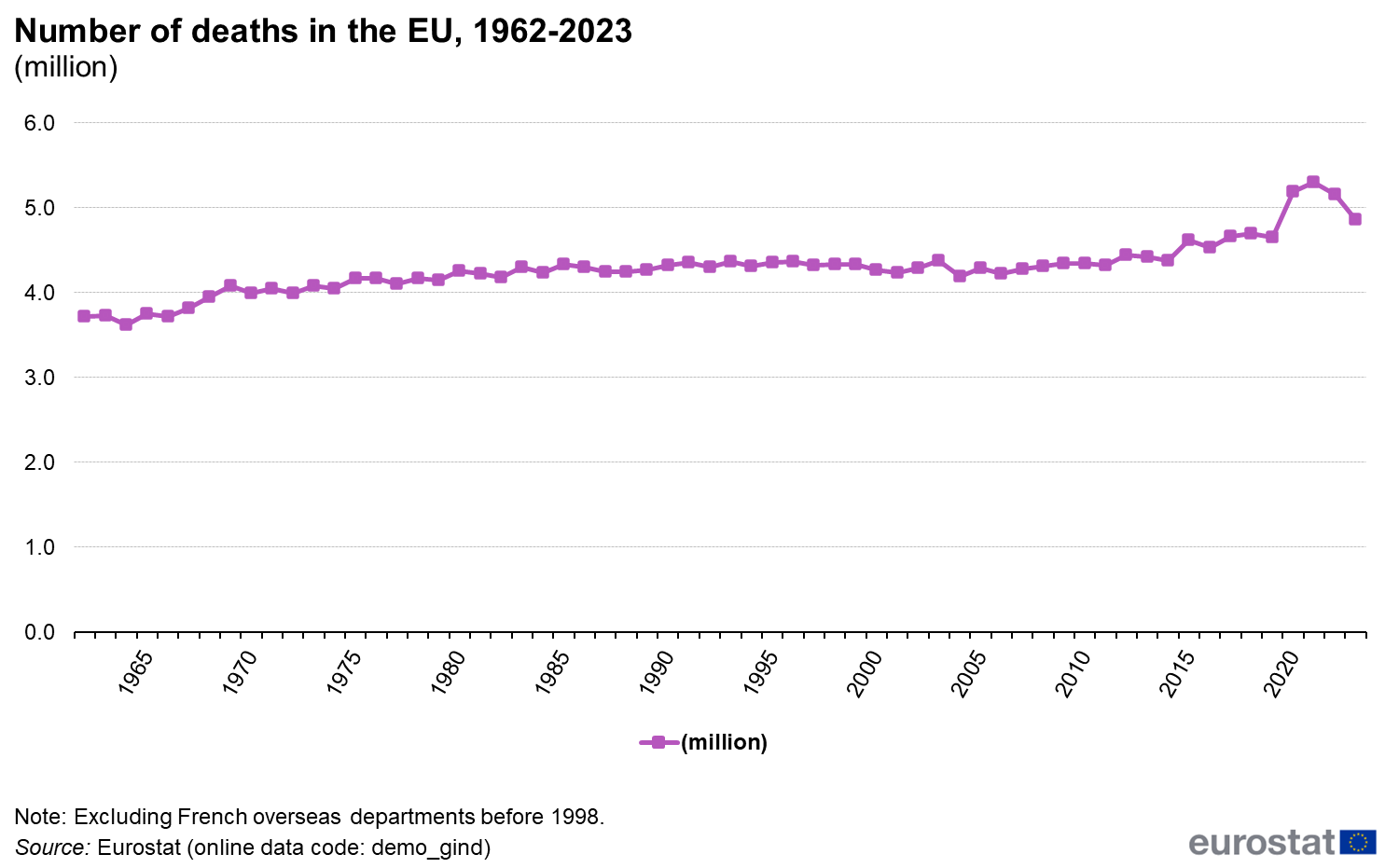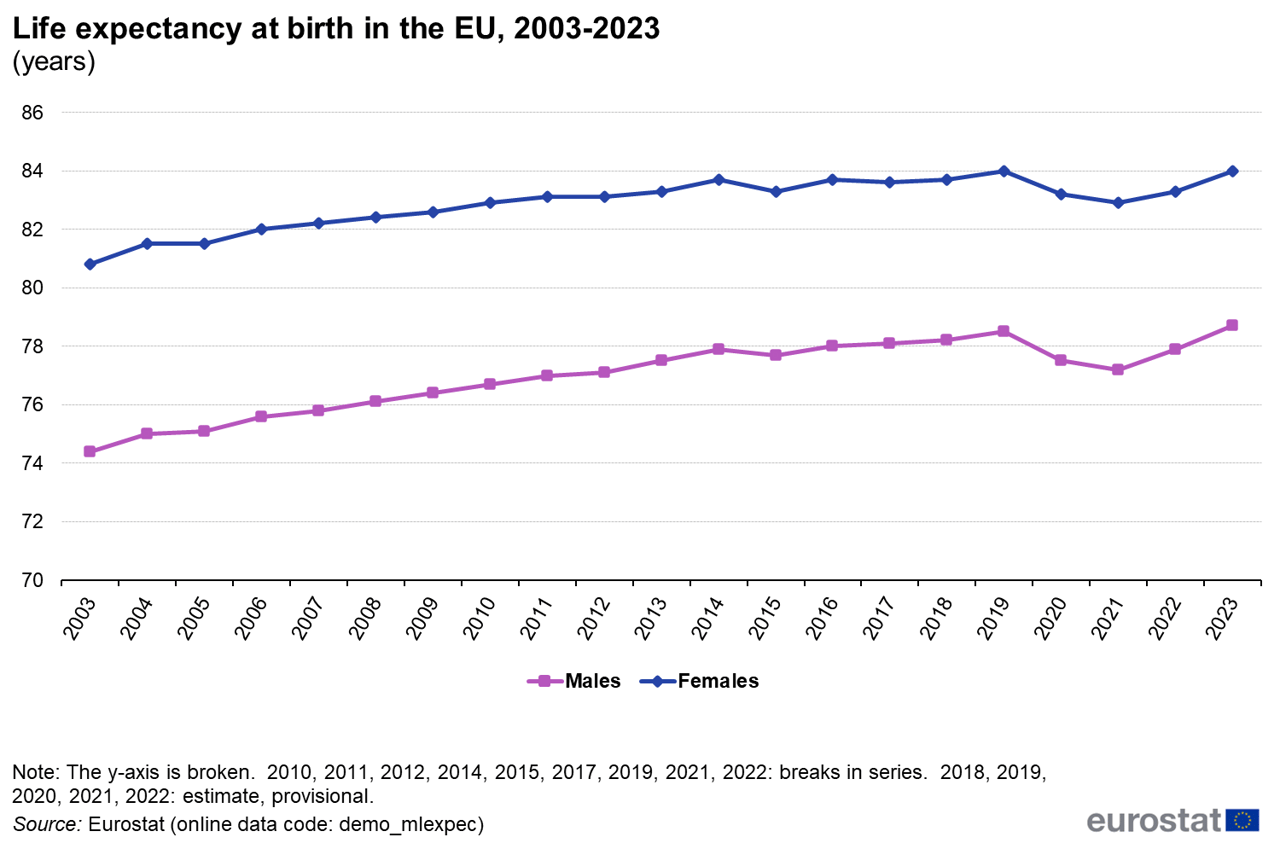Analysis
Europe’s mortality map: which diseases are most lethal in each country?
Every year, more than five million people die in European Union countries. The leading cause is cardiovascular disease, which accounts for 32 percent of these deaths. This is followed by cancer, with 22 percent, according to the latest Eurostat data for 2022.
That year, Covid-19 still had a significant impact on European mortality, accounting for the leading cause in six percent of cases and up to one-in-ten in Greece and Slovenia. Nevertheless, figures vary widely from country to country.
Spain has one of the lowest heart disease death rates in Europe, accounting for 26 percent of all deaths. Only France has a lower rate, at 21 percent.
In contrast, these figures are much higher in Bulgaria (61 percent), Romania (56 percent) and Lithuania (52 percent).
“Europe is divided into three risk zones, with eastern European countries and some northern European countries being high risk,” explains Dr Luis Rodríguez Padial, president of the Spanish Society of Cardiology (SEC).
The probability of having a cardiovascular problem is higher in these areas than in low-risk areas, located in the Mediterranean region.
The cardiologist attributes these differences to the risk factors associated with this type of disease. “People smoke more, have higher cholesterol and there are probably also genetic factors,” he explains, although he says that the importance of the latter is less well-known.
According to Eurostat, Bulgaria leads several negative health indicators in the EU, with the heaviest smoking habits (29 percent compared to the EU average of 19 percent).
The country also has high alcohol consumption and nearly 30 percent of the population does not engage in any physical activity, according to the Bulgarian media outlet Mediapool.
Despite national programmes to improve these factors, prevention and early detection remain persistent weaknesses.
In an interview with News.ro, Dr Ștefan Busnatu, a cardiologist in Romania, points to a worrying situation, confirming that his country is “unfortunately” in an area where “there is a very high risk of disease”.
In his opinion, there is not enough infrastructure to manage ischaemic heart disease, which limits treatment. For him, the emphasis on prevention, education and cardiac rehabilitation is crucial, as a second acute ischaemic event can be fatal.
“It is evident that more people die of heart disease in Russia or in eastern European countries than in Spain, Italy or Greece and the Mediterranean area. This is probably due to the famous Mediterranean diet,” says Rodríguez.
He refers to an article published in March in the medical journal New England, whose main finding is that the presence of the five classic risk factors (high blood pressure, high cholesterol, abnormal weight, diabetes and smoking) account for 50 percent of global cases of cardiovascular disease.

At the same time, the absence of these factors after the age of 50 is associated with a decade longer life expectancy than those who do have them.
The president of the Lithuanian Heart Association, cardiologist Sigita Glaveckaitė, spoke on television about the incidence of these diseases in her country.
Beyond the “high” prevalence of risk factors, the doctor referred to other problems such as beliefs or myths that discourage people from taking the appropriate medication, poor health education, low participation in prevention programmes and lack of state funding.
In her experience, the healthcare system has an approach inherited from the Soviet system, where professionals are paid by the hour rather than by procedure, which reduces efficiency and interest in the work.
“When I ask patients (patients under 60 after a heart attack), they almost always smoke, are obese, do not treat their high blood pressure or do not take cholesterol medication,” says cardiologist Josef Kautzner from the Czech Republic.
“We know that approximately 80 percent of cardiovascular diseases can be prevented by minimising seemingly simple but essential risk factors,” insists Glaveckaitė.
Along the same lines, the latest report on health in Europe by the OECD and the European Commission explains the differences between countries by the variability in the prevalence of risk factors. But it also points to the quality of healthcare.
“For example, 30-day mortality after a heart attack (which reflects aspects such as how quickly patients are transported to hospital and how effective their medical treatment was) was over 14 percent in Latvia, Slovakia, Lithuania and Estonia in 2021, compared to seven percent or less in Sweden, Denmark and Spain,” the report states.
For their part, men have 43 percent higher mortality rates from circulatory diseases than women in the EU, according to OECD data, and this gender gap has widened slightly over the last decade. This difference is due to the higher prevalence of key risk factors among them.
The data confirms that the incidence of these diseases directly affects life expectancy in countries. As shown in the graph above, life expectancy is shorter in places where the percentage of deaths from cardiovascular disease is higher.
Poland has one of the widest gaps in life expectancy between men and women.
“Women in Poland currently live about two years less than the average woman in the European Union. For men, the difference is four years. This is something that has affected Poland since socio-demographic changes began to be tracked,” explains Dr Bogdan Wojtyniak of the National Institute of Public Health.

Cancer mortality and educational attainment
Malignant cancers are the second leading cause of death in Europe, although in some countries they are the leading cause.
In fact, the most recent data for Spain, published by the INE for 2024, place tumours as the leading cause of death (26.6 percent), followed by diseases of the circulatory system (26.1 percent).
The OECD report also highlights differences within countries themselves: “Large disparities in cancer mortality (over 30 percent) have been found between regions in Romania, Poland, France, Spain and Germany.”
In addition to risk and hereditary factors, a study on educational inequalities in cancer mortality between 2015 and 2019 revealed that, in 14 EU countries and Norway, men with lower educational attainment had a cancer mortality rate 84 percent higher, on average, than men with higher educational attainment.
"The gap between women with different levels of education was narrower, but still considerable at 37 percent,” the OECD states.
According to the organisation, in several countries, cancer survival rates are lower among people in poorer socioeconomic groups. These inequalities reflect differences in the prevalence of risk factors, participation in screening programmes and access to timely and high-quality healthcare.
Research published in The Lancet Public Health also analysed differences in years of life lost early deaths in 32 European countries. The results indicated that disparities were strongly associated with socioeconomic factors, access to health services and public policies. Thus, countries with lower investment in public health and greater economic inequality showed higher rates of premature mortality.
More traffic accidents
In addition to natural factors, external causes of mortality also reflect differences between countries. Traffic accidents have a higher impact on mortality in southern Greece, some regions of Portugal, Romania and Turkey.
In 2024, Greece reached a record 665 deaths from traffic accidents. The organisation SOS Traffic Crimes criticises the lack of progress in the government’s goal of halving deaths by 2030. They claim that in recent years, not only has the number of accidents not fallen but, since 2021, there have been more deaths from traffic accidents.
George Kouvidis, founder of the SOS Traffic Crimes, mentions the complex case of the Morea motorway, where, despite supposedly being a safer road, accidents increased by more than 100 percent after its completion in 2016.
He attributes this to the fact that drivers, with more powerful cars, entered the provincial networks at high speeds and without the necessary caution on roads with different infrastructure. On the islands, the increase is explained by tourism and alcohol consumption.
However, Kouvidis points out that European accident statistics often exclude countries with worse rates (such as Albania, Serbia and Kosovo), distorting the continent’s figures. He also considers it “unacceptable” that these death figures do not include those who die more than 30 days after an accident.
Suicide rates in European countries range from around two to 20 per 100,000 inhabitants.
The countries with the highest suicide rates are Slovenia, Lithuania, Hungary, Belgium and Estonia.
A study published in 2016 in BioMed Central analysed the differences between these rates in Europe and concluded that, among other factors, cold weather correlates with a higher suicide rate.
“It seems that in Europe, suicidality follows a climate or temperature gradient that, curiously, does not run from south to north, but from south to northeast,” the article states.
Despite this, the Association of Professionals in Suicide Prevention and Postvention (Papageno) points out that there are generally “multiple causes when we talk about suicide”.
Homicides are not a common cause of death on the continent, but in 2022 the rates were highest in Latvia, Lithuania and Luxembourg, while Spain is just below the European average, with 0.62 deaths per 100,000 inhabitants.
Translated by Albie Mills (Voxeurop)
This article was produced as part of the PULSE, a European initiative supporting cross-border journalistic cooperation. It was first published on El Confidencial.
This year, we turn 25 and are looking for 2,500 new supporting members to take their stake in EU democracy. A functioning EU relies on a well-informed public – you.